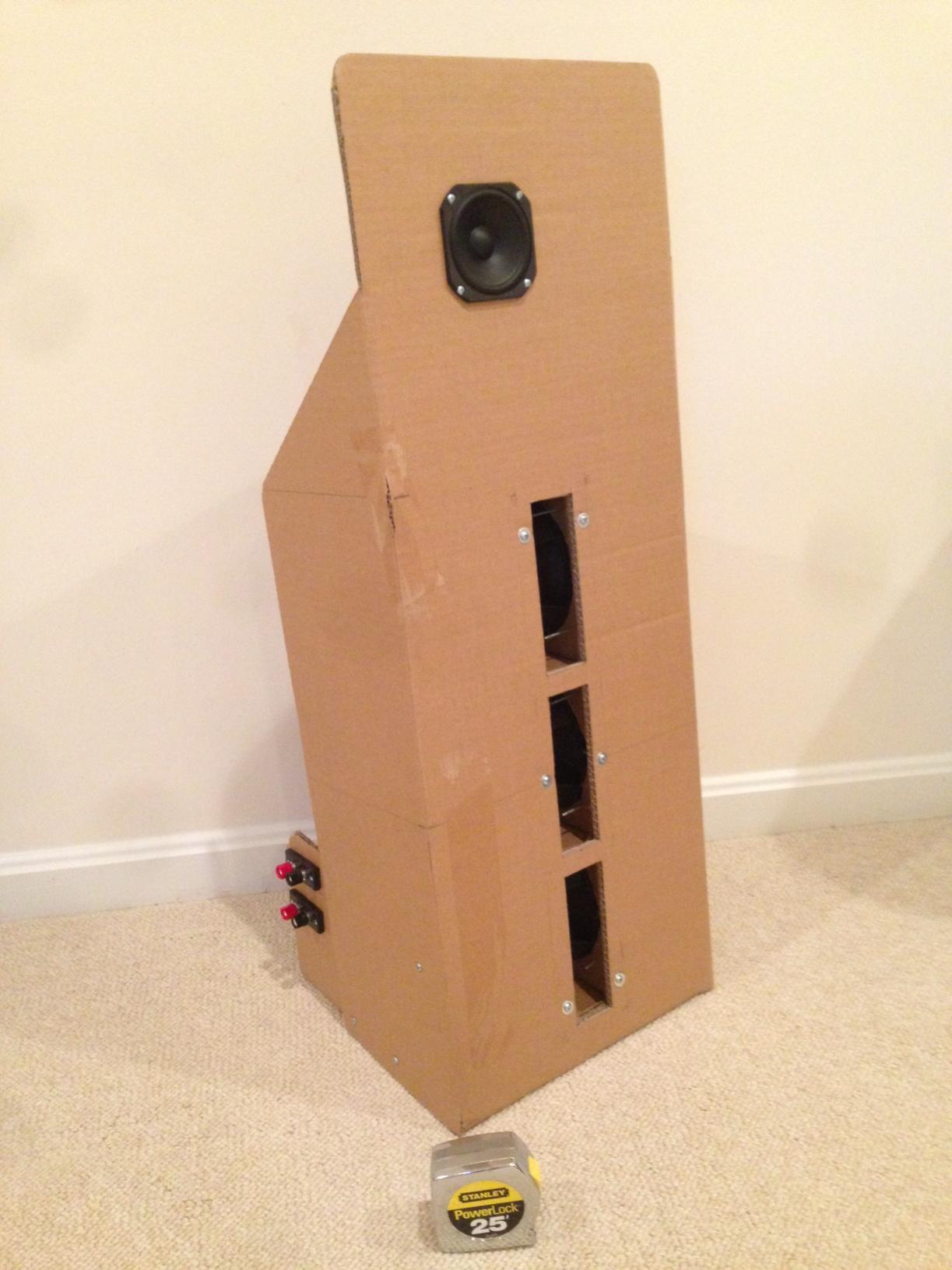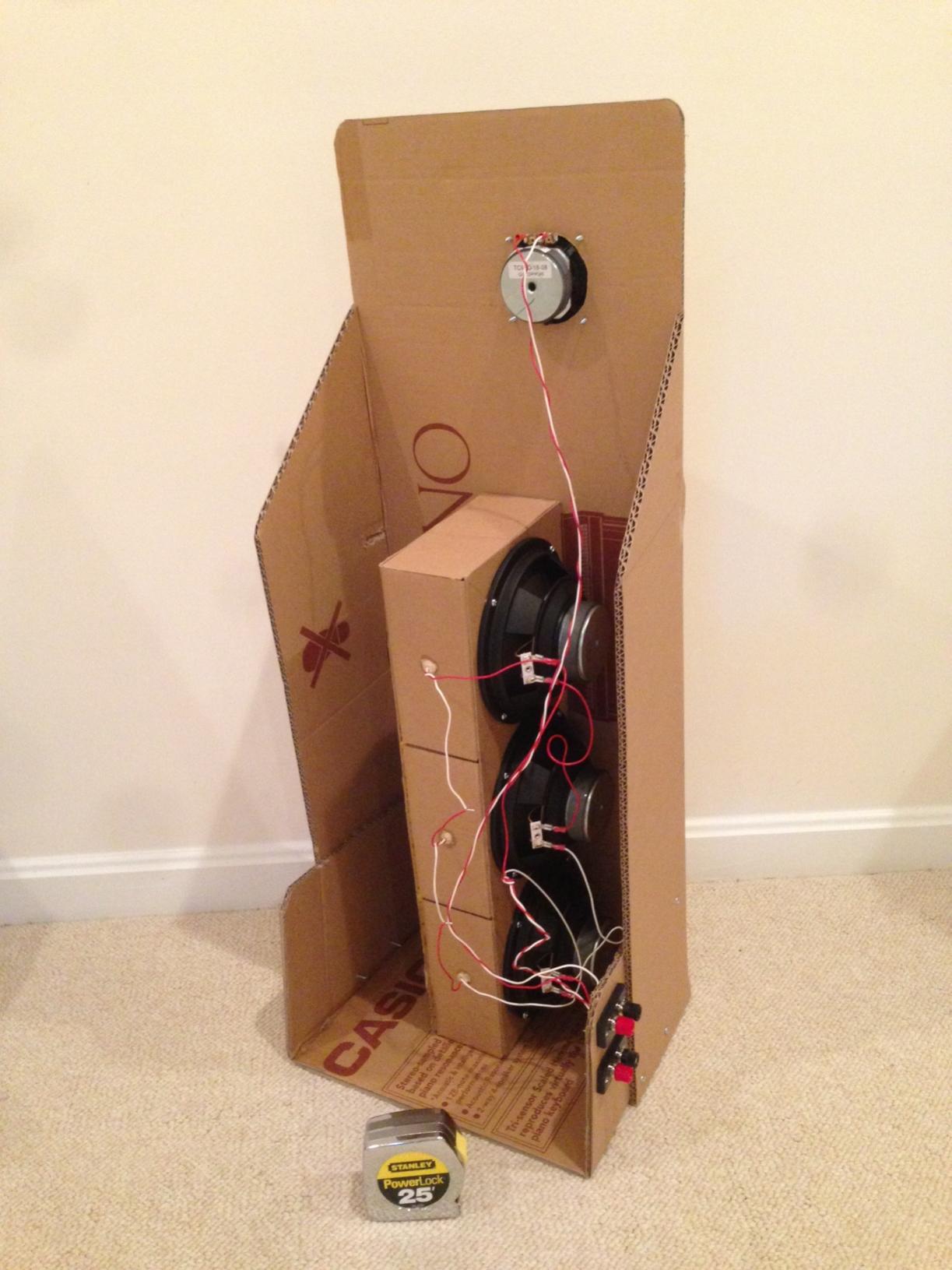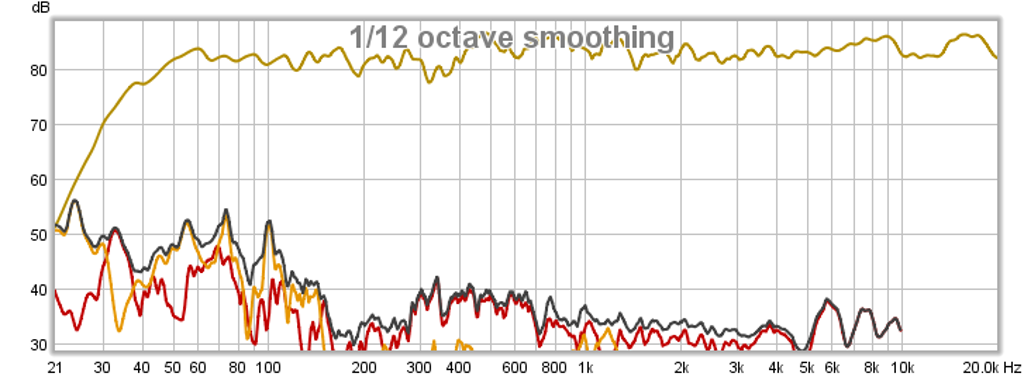Way way back.post #2 in this thread
26th January 2014, 12:51 PM #2
LOL that was the very first version with one 6.5 woofer and all running full range no XO! It sounded awful. Yes it lacks bass which is why I added 5 woofers in slot loaded open baffle or SLOB. With a xo it sounds much much better. Clips on this post.
http://www.diyaudio.com/forums/full-range/249984-cheap-fast-ob-literally-8.html#post3807593
Will look at these. SLOB won't really be a nice name to market these. By the way, what is the test equipment you are using? Any android based apps that give accurate results or do you need a Senheiser microphone and an oscilloscope? What about a PC?
A PC is what I use. Get REW software for free. Buy a calibrated USB mic like UMIK-1 or Dayton UMM-6. Then avoid having to have audio interface box/board. You can also make a mic with Panasonic WM-6A capsule ($2) it will be plus minus 2dB. Search for that mic and plans for wiring it are available.
Dayton sells iMM-6 mic that plugs in iPhone or Android phone with app. $15. I have not used it so can't say how well it works.
$70 for mic and a PC will do most everything you see me do.
Dayton sells iMM-6 mic that plugs in iPhone or Android phone with app. $15. I have not used it so can't say how well it works.
$70 for mic and a PC will do most everything you see me do.
Thanks, good to know, especially the WM-6A which needs only a resistor and capacitor according to the datasheet. I use Ubuntu so free software should be easy to obtain.
Have you posted these details in the 'Software Tools' section? Or are they aware?
Have you posted these details in the 'Software Tools' section? Or are they aware?
It's basic stuff - everyone now uses REW and everyone who is serious about diy sooner or later buys a calibrated mic. I don't know about good tools in Linux. I can tell you that REW as a software package does for free what would have cost probably $10k to $20k in software and gear maybe 15 years ago. It has a lot of analysis tools and is more than just measure the frequency response. If you have an old XP laptop, etc, I highly encourage using Windows and REW. Maybe you have a virtual PC from Ubuntu - but that may have issues as REW needs to work directly with USB driver for high speed data acquisition from microphone.
Ok, son 64K question is how accurate is it, and does it enhance your musical experience?
For example have you compared HiFi magazine tests with your tests - assuming you have the same speakers?
For example have you compared HiFi magazine tests with your tests - assuming you have the same speakers?
REW is avalailable as JAR files, I use it in Ubuntu. No need for Windows if one does not want to. Also Arta works fine in Ubuntu, using Wine. Arta isn't freeware though, but worth the license fee of 79 euros. There are differences between the those, I prefer Arta. I have an automation script to run angled measurements with it. REW is free to use and offers handy tools for active crossovers and it is a bit easier to learn.
Last edited:
LOL that was the very first version with one 6.5 woofer and all running full range no XO! It sounded awful. Yes it lacks bass which is why I added 5 woofers in slot loaded open baffle or SLOB. With a xo it sounds much much better. Clips on this post.
Cheap and FAST OB, Literally
Just listened to the clips on my headphones as far as I could tell your speakers have a clear, totally distortion free response, bass is also good, however the lack of distortion is really notable it reminds me of listening to my car Pioneer car stereo (like this one) which has some great electronics - very low noise and good punch. Any photos of the SLOB?
Photos of the SLOB in post #67


Here is the measured HD, it is quite low above 400Hz - but that is just the inherent capability of the TC9FD - an excellent sounding driver.

If you think the low HD sounds good and is noticeable to you - you may be sensitive to it. Many people can't hear HD less than -21dB. In the Klippel HD test I can hear it down to -45dB. The TC9FD when played at average listening levels has -50dB HD as you can see. This is why it particularly sounds very good to me.
I also made a SLOB with a PRV 5MR450NDY mid (full range) driver on top that has even lower HD than the TC9FD. That is in another thread: http://www.diyaudio.com/forums/full-range/259293-prv-5mr450-ndy-fast-applications.html


Here is the measured HD, it is quite low above 400Hz - but that is just the inherent capability of the TC9FD - an excellent sounding driver.

If you think the low HD sounds good and is noticeable to you - you may be sensitive to it. Many people can't hear HD less than -21dB. In the Klippel HD test I can hear it down to -45dB. The TC9FD when played at average listening levels has -50dB HD as you can see. This is why it particularly sounds very good to me.
I also made a SLOB with a PRV 5MR450NDY mid (full range) driver on top that has even lower HD than the TC9FD. That is in another thread: http://www.diyaudio.com/forums/full-range/259293-prv-5mr450-ndy-fast-applications.html
Last edited:
average listening levels
Right now my all my efforts are concentrated around the 75-80 dB SPL /W/m listening levels. Unlike in younger days I cannot really turn up the volumes now I need to carry out a conversation and be able to hear what people say at the same time as listening to music.
Listening at these levels really affects the bass - so my speakers and my music, possibly mildly equalized, will have to be able to display a good bass presence at these levels. I remember having to turn up the volume in order to 'hear all the sounds'. CD's are fine, MP3 is ok FM radio is the worst. Do you listen to radio at all?
How are your speakers at low sound levels, have you tested them at 65-70-75-80-85 levels as well?
Last edited:
That's the nice thing about open baffle dipole bass like the SLOB, it works very well at lower SPL's. It doesn't need to pressurize the room and generate room modes. It has defined clear bass but the bass falls off as you get farther away. With conventional monopole bass, there are spots farther away that are stronger but it varies as you move about. With dipole bass the relationship is that it falls off with distance more consistently.
Dipole bass is not as efficient as monopole bass so you need lots of cone surface area and stroke. Hence people use 1 or even 2 15in woofers. For the SLOB 6 x 6.5in woofers were used in my case or equivalent to about a 15in driver. Even better would be 6 or 8 x 8in woofers in a SLOB.
Dipole bass is not as efficient as monopole bass so you need lots of cone surface area and stroke. Hence people use 1 or even 2 15in woofers. For the SLOB 6 x 6.5in woofers were used in my case or equivalent to about a 15in driver. Even better would be 6 or 8 x 8in woofers in a SLOB.
Would be nice to see a graph of response at different SPL's. Ever mapped a 3D image of the response I think it is called the waterfall graph. That would highlight standing waves and high spots in the room.
Sorry, my system has been dismantled long ago. There are plenty of other builds of SLOBs you might want to look around at other people's data. It doesn't do any good to show room data because that is room dependent. Software I use is REW - it does waterfalls, and the lower frequencies do show energy storage in room.
You can read up on theory of dipole woofers in SL's website:
Electro-acoustic models
Dipole Woofer
You can read up on theory of dipole woofers in SL's website:
Electro-acoustic models
Dipole Woofer
Thanks for the links. Reading...
This very interesting video- on an online learning course - you may want to register- illustrates the open baffle concept.
After demonstrating the effect of the capacitor, the instructor removes the speaker driver from the box, thereby instantly converting it into an open baffle type.
I closed my eyes at that point and tried to detect the moment the speaker was removed from the box - I could not really, however when the speaker was placed back in the box I instantly heard the muffled bass sounds coming back into prominence.
So is that what an enclosure does, muffle the bass sounds and make them louder - does not seem to be a very good way of obtaining detailled bass. Of course it depends on the design, this one is not ported.
In a moment the open box concept was validated before my eyes.
What do you think?
This very interesting video- on an online learning course - you may want to register- illustrates the open baffle concept.
After demonstrating the effect of the capacitor, the instructor removes the speaker driver from the box, thereby instantly converting it into an open baffle type.
I closed my eyes at that point and tried to detect the moment the speaker was removed from the box - I could not really, however when the speaker was placed back in the box I instantly heard the muffled bass sounds coming back into prominence.
So is that what an enclosure does, muffle the bass sounds and make them louder - does not seem to be a very good way of obtaining detailled bass. Of course it depends on the design, this one is not ported.
In a moment the open box concept was validated before my eyes.
What do you think?
I found some high quality double wall cardboard from a piano packing box. Too good to pass up without repurposing it to something useful, still related to music...
The design is similar to my sims for the 6.5 in PE buyout polycone woofer with a 12 in wide baffle. The slot loaded chamber was made from three of the boxes that the drivers came in and provided a 7 in deep x 7 in tall x 3 in wide chamber times three. The slots are 1.75 in wide x 6 in tall times three.
Sorry to dig up an old thread but besides the fact that you were repurposing the boxes from the drivers for a quick mock-up (and probably needed the structural stability of the additional facets) is there a reason you kept each pair of drivers in their own slots vs having all 6 share one 7x21x3 slot? Would there have been any benefit of having a shared slot like in the Pass Slot design, or does it matter?
It doesn’t matter regarding the bracing/dividers except they add structural rigidity. Even with plywood there is significant pressure build up in that slot.
This has always been one of my favorite prototypes built in cardboard or foamcore. It was so good I made a note to myself to revisit it one day in wood. It was one of those designs that has such a clear midrange thanks to being an open baffle and deep bass that had some punch when you are nearby but doesn’t compress the room. I have recently been working with a local cabinet maker to help me realize the the next generation in wood. I’m increasing the woofers to 8x 6.5in per speaker, and making it a 3 way with a high sensitivity midbass (5FE100 or 6FE100) and a planar dipole tweeter (GRS) with a waveguide. The woofers are basic polycone or papercone low cost units for now. Fancy ones are not needed as I recall how good they sounded with $5 blowout woofers.
The construction will use mostly 3/4in BB ply for the baffle and 1/2in BB ply for the U-wings and stacked 3/4in MDF for the woofer manifold chamber. The 2-way part will be on a separate board that is interchangeable so that I can test out various different drivers on top easily. I plan to develop a passive crossover.
Construction is almost completed and I should have the speaker in hand in a few days. Right now it is still at the workshop. It’s looking very nice thanks to the superb skills of my cabinet maker, Doug. A big hats off to you Doug!
Woofer manifold made from stacked MDF:

Manifolds glued to baffle:

Preparing to install the wings:


Baffles with cutouts for replaceable 2-way top driver plates:

Detail of how baffle plates are held in place from the back:

Woofers are rear mounted and tweeter waveguide is front mounted. Woofer bezels are rather industrial “pro audio” so look better rear mounted. Also, the non-circular bezels would have made front flush mount rebates a real pain. A round over on the front lip is used to provide a smoother look and reduce diffraction to the extent possible:

Will probably use some bracing on the wings:

This is going to be a fun speaker to develop the crossover for.
The construction will use mostly 3/4in BB ply for the baffle and 1/2in BB ply for the U-wings and stacked 3/4in MDF for the woofer manifold chamber. The 2-way part will be on a separate board that is interchangeable so that I can test out various different drivers on top easily. I plan to develop a passive crossover.
Construction is almost completed and I should have the speaker in hand in a few days. Right now it is still at the workshop. It’s looking very nice thanks to the superb skills of my cabinet maker, Doug. A big hats off to you Doug!
Woofer manifold made from stacked MDF:
Manifolds glued to baffle:
Preparing to install the wings:
Baffles with cutouts for replaceable 2-way top driver plates:
Detail of how baffle plates are held in place from the back:
Woofers are rear mounted and tweeter waveguide is front mounted. Woofer bezels are rather industrial “pro audio” so look better rear mounted. Also, the non-circular bezels would have made front flush mount rebates a real pain. A round over on the front lip is used to provide a smoother look and reduce diffraction to the extent possible:
Will probably use some bracing on the wings:
This is going to be a fun speaker to develop the crossover for.
Last edited:
Speakers delivered. They look gorgeous in person and are much more compact (and SWMBO friendly) than I thought. 🙂
They measure 12.0in wide x 44.5in tall x 14.0in deep.
I am wondering what color stain to use, deep espresso brown or a more reddish cherry?








They measure 12.0in wide x 44.5in tall x 14.0in deep.
I am wondering what color stain to use, deep espresso brown or a more reddish cherry?
- Home
- Loudspeakers
- Full Range
- Cheap and FAST OB, Literally